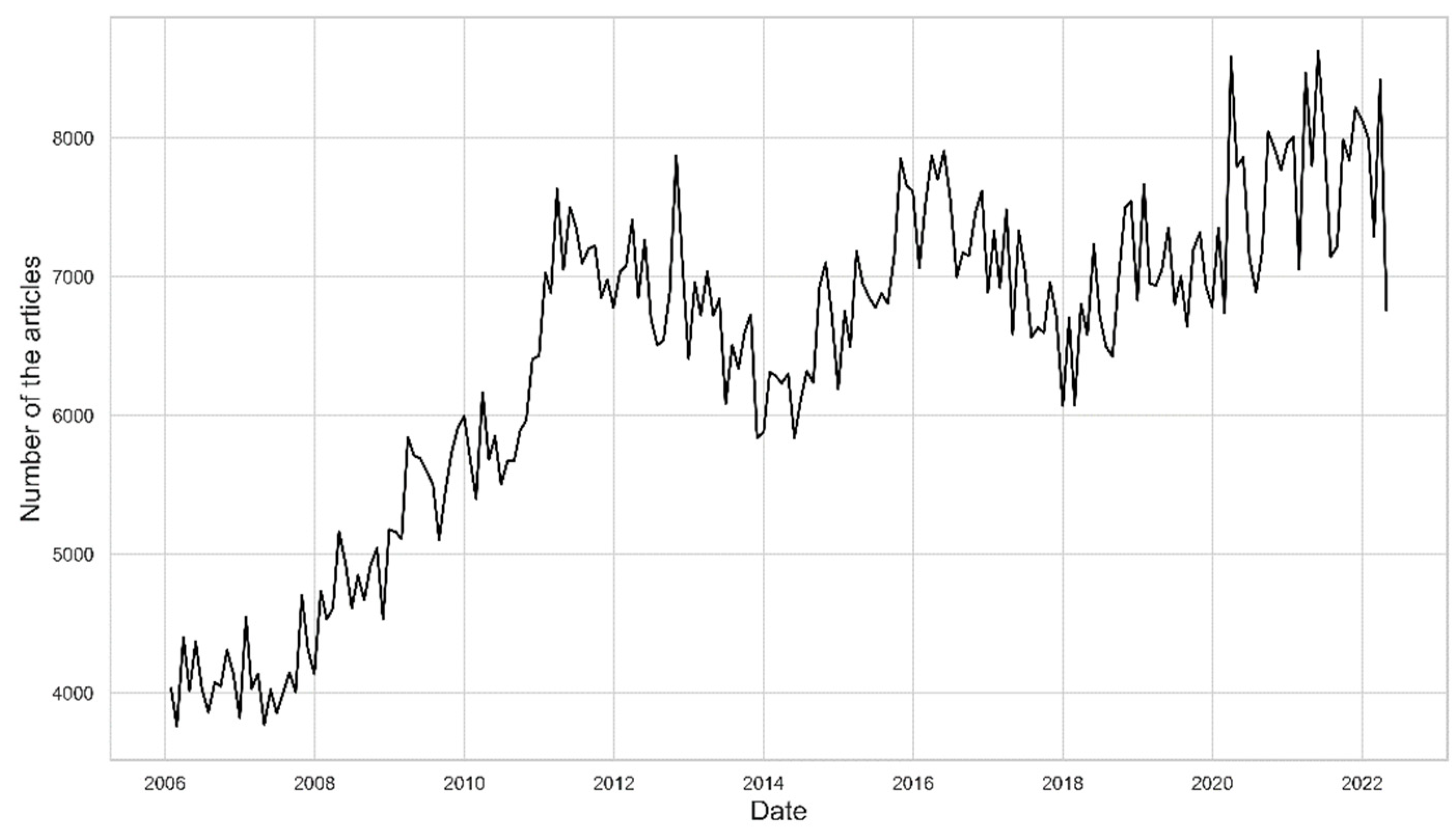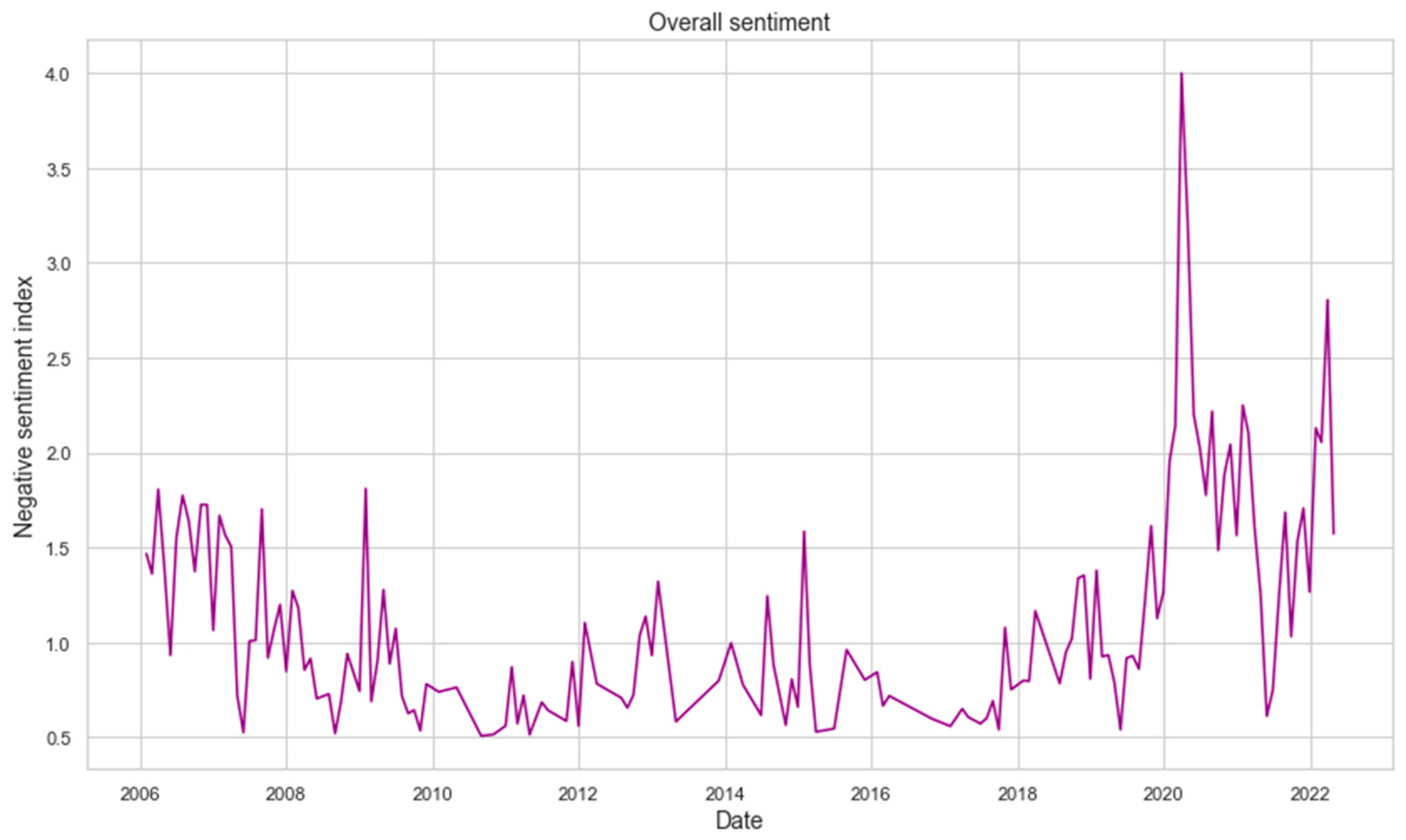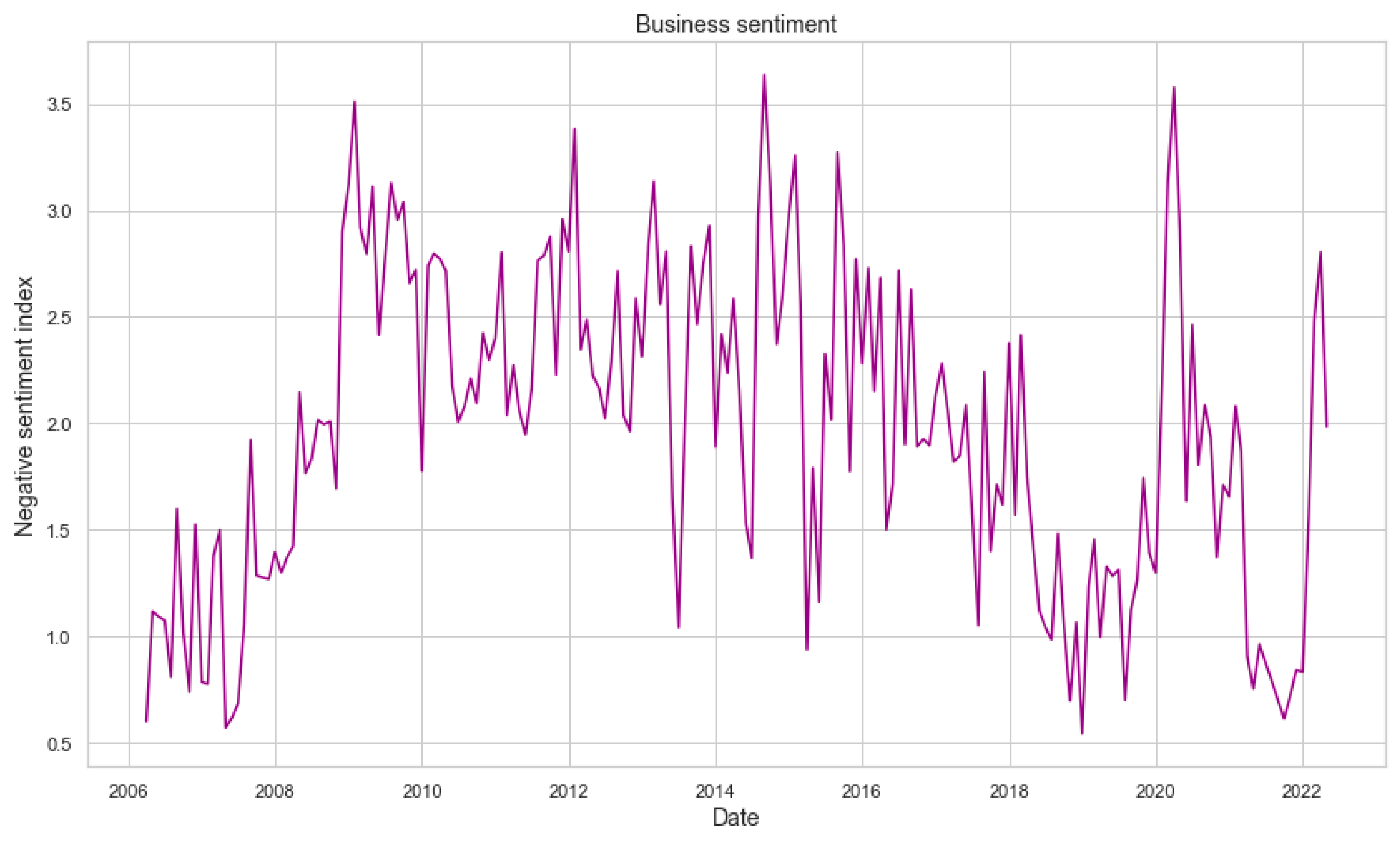Evaluation of News Sentiment in Economic Activity Forecasting †
Abstract
:Featured Application
Abstract
1. Introduction
2. Materials and Methods
3. Results
4. Discussion
Author Contributions
Funding
Institutional Review Board Statement
Informed Consent Statement
Data Availability Statement
Acknowledgments
Conflicts of Interest
References
- Wang, Y.; Zhang, J.; Zhai, F.; Xu, J.; Zong, C. Three strategies to improve one-to-many multilingual translation. In Proceedings of the 2018 Conference on Empirical Methods in Natural Language Processing, Brussels, Belgium, 31 October–4 November 2018; pp. 2955–2960. [Google Scholar]
- Napoles, C.; Sakaguchi, K.; Post, M.; Tetreault, J. Ground truth for grammatical error correction metrics. In Proceedings of the 53rd Annual Meeting of the Association for Computational Linguistics and the 7th International Joint Conference on Natural Language Processing (Volume 2: Short Papers), Beijing, China, 26–31 July 2015; pp. 588–593. [Google Scholar]
- Khurana, D.; Koli, A.; Khatter, K.; Singh, S. Natural language processing: State of the art, current trends and challenges. Multimed. Tools Appl. 2022, 82, 3713–3744. [Google Scholar] [CrossRef] [PubMed]
- Mittal, Y.; Toshniwal, P.; Sharma, S.; Singhal, D.; Gupta, R.; Mittal, V.K. A voice-controlled multi-functional smart home automation system. In Proceedings of the 2015 Annual IEEE India Conference (INDICON), New Delhi, India, 17–20 December 2015; pp. 1–6. [Google Scholar]
- de Oliveira, N.R.; Pisa, P.S.; Lopez, M.A.; de Medeiros, D.S.V.; Mattos, D.M. Identifying fake news on social networks based on natural language processing: Trends and challenges. Information 2021, 12, 38. [Google Scholar] [CrossRef]
- Taj, S.; Shaikh, B.B.; Meghji, A.F. Sentiment analysis of news articles: A lexicon based approach. In Proceedings of the 2019 2nd International Conference on Computing, Mathematics and Engineering Technologies (iCoMET), Sukkur, Pakistan, 30–31 January 2019; pp. 1–5. [Google Scholar]
- Baker, S.R.; Bloom, N.; Davis, S.J. Measuring economic policy uncertainty. Q. J. Econ. 2016, 131, 1593–1636. [Google Scholar] [CrossRef]
- Shapiro, A.H.; Sudhof, M.; Wilson, D.J. Measuring news sentiment. J. Econom. 2020, 228, 221–243. [Google Scholar] [CrossRef]
- Huang, A.; Wang, H.; Yang, Y. FinBERT—A Deep Learning Approach to Extracting Textual Information. 2020. Available online: https://ssrn.com/abstract=3910214 (accessed on 15 September 2022).
- Rosenthal, S.; Farra, N.; Nakov, P. SemEval-2017 task 4: Sentiment analysis in Twitter. arXiv 2019, arXiv:1912.00741. [Google Scholar]
- Lukauskas, M.; Ruzgas, T. A New Clustering Method Based on the Inversion Formula. Mathematics 2022, 10, 2559. [Google Scholar] [CrossRef]



| Data/Model | RMSE | MAE | MAPE | |||
|---|---|---|---|---|---|---|
| Mean | Std | Mean | Std | Mean | Std | |
| Monthly inflation rate | ||||||
| Univariate | 0.217 | 0.016 | 0.153 | 0.008 | 0.348 | 0.017 |
| Overall sentiment | 0.134 | 0.005 | 0.097 | 0.002 | 0.243 | 0.011 |
| All sentiments | 0.219 | 0.011 | 0.159 | 0.006 | 0.379 | 0.034 |
| Biggest cluster | 0.218 | 0.014 | 0.109 | 0.007 | 0.345 | 0.047 |
| Annual inflation rate | ||||||
| Univariate | 0.097 | 0.015 | 0.064 | 0.015 | 0.303 | 0.050 |
| Overall sentiment | 0.072 | 0.009 | 0.051 | 0.007 | 0.293 | 0.045 |
| All sentiments | 0.116 | 0.061 | 0.088 | 0.048 | 0.301 | 0.127 |
| Biggest cluster | 0.126 | 0.067 | 0.087 | 0.051 | 0.305 | 0.168 |
| Production index | ||||||
| Univariate | 0.224 | 0.013 | 0.187 | 0.015 | 0.446 | 0.041 |
| Lithuania sentiment | 0.099 | 0.005 | 0.079 | 0.005 | 0.162 | 0.012 |
| All sentiments | 0.152 | 0.012 | 0.088 | 0.011 | 0.177 | 0.013 |
| Biggest cluster | 0.166 | 0.024 | 0.093 | 0.022 | 0.198 | 0.022 |
Disclaimer/Publisher’s Note: The statements, opinions and data contained in all publications are solely those of the individual author(s) and contributor(s) and not of MDPI and/or the editor(s). MDPI and/or the editor(s) disclaim responsibility for any injury to people or property resulting from any ideas, methods, instructions or products referred to in the content. |
© 2022 by the authors. Licensee MDPI, Basel, Switzerland. This article is an open access article distributed under the terms and conditions of the Creative Commons Attribution (CC BY) license (https://creativecommons.org/licenses/by/4.0/).
Share and Cite
Lukauskas, M.; Pilinkienė, V.; Bruneckienė, J.; Stundžienė, A.; Grybauskas, A.; Ruzgas, T. Evaluation of News Sentiment in Economic Activity Forecasting. Eng. Proc. 2023, 31, 7. https://doi.org/10.3390/ASEC2022-13790
Lukauskas M, Pilinkienė V, Bruneckienė J, Stundžienė A, Grybauskas A, Ruzgas T. Evaluation of News Sentiment in Economic Activity Forecasting. Engineering Proceedings. 2023; 31(1):7. https://doi.org/10.3390/ASEC2022-13790
Chicago/Turabian StyleLukauskas, Mantas, Vaida Pilinkienė, Jurgita Bruneckienė, Alina Stundžienė, Andrius Grybauskas, and Tomas Ruzgas. 2023. "Evaluation of News Sentiment in Economic Activity Forecasting" Engineering Proceedings 31, no. 1: 7. https://doi.org/10.3390/ASEC2022-13790
APA StyleLukauskas, M., Pilinkienė, V., Bruneckienė, J., Stundžienė, A., Grybauskas, A., & Ruzgas, T. (2023). Evaluation of News Sentiment in Economic Activity Forecasting. Engineering Proceedings, 31(1), 7. https://doi.org/10.3390/ASEC2022-13790






